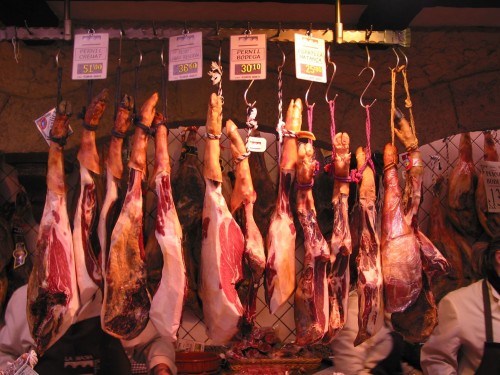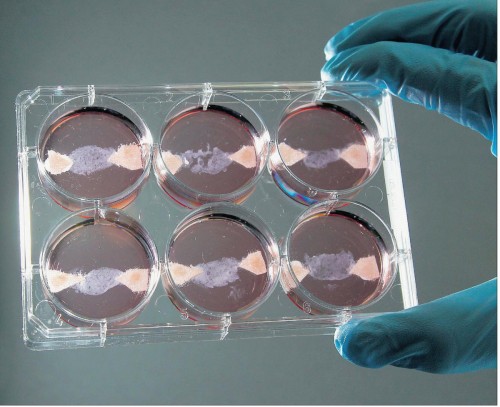Imagine sitting down at the dinner table and staring at a green algae sludge soup, a grilled grasshopper appetizer, and an entrée consisting of thin turkey strips grown in a large glass vat. It may not be an enticing image, but one or more of these cuisines may grace your family meals sooner than you think.
The issues of food security and of meeting the nutritional demands of a growing world population are constant challenges that many scientists and policy makers are trying to address today. But it is certainly no simple task: at current rates, the global population is projected to reach 9 billion people by 2050. In other words, science must act fast if we expect to maintain the health and nutrition of an already burgeoning society.
No More Room
According to the estimates of the Food and Agriculture Organization of the United Nations, current food production must be doubled by 2050 in order to keep up with future demands from population growth and dietary changes. But how exactly can farmers and other food manufacturers double production? Agriculture, which includes croplands and pastures, already occupies nearly 40 percent of the earth’s terrestrial surface. The rest of the planet is covered by deserts, mountains, and other lands unsuited for additional cultivation. Radical climate changes and expanding water shortages further impede agricultural developments. Simply put, there is not enough space or resources to readily expand food production in the traditional way we have always done.

Algae, Insects, and Genetically Modified Foods
Several creative techniques are being developed to find alternatives for sustainable food production. One idea has been to harness the simplicity, diversity, and robustness of algae. Commercial algae farms can be constructed in places unsuitable for conventional agriculture and can yield enormous amounts of algae with minimal cost of resources. In addition to providing a source of nutrition for humans, algae can also act as animal feed, fertilizer, and biofuel.
“Micro-livestock farming,” which involves large-scale insect rearing farms, is another potential avenue to tackle the food production problem. Insects are high in protein, calcium, and iron, while low in cholesterol and fat. In comparison to conventional livestock like cows and pigs, insects require much less land and resources to grow and reproduce, emit much less greenhouse gases, and can more efficiently convert biomass into protein. However, it is difficult to appease the Western palate with beetles, spiders, and worms, even though hundreds of species of insects are eaten in Asia, Africa, and South America.
The advent of genetic engineering technologies about two decades ago has also restructured approaches to food production and security. Scientists currently use these novel techniques such as microinjection and bioballistics to modify genes inside crops like corn, soybeans, and tomatoes. These genetically modified foods have enhanced traits, whether it is improved crop yield, increased resistance to plant diseases and pests, increased shelf life, or enhanced nutritional value. While genetic engineering approaches have permeated most areas of agriculture to improve crops (around 90 percent of soybeans, corn, and canola grown in America are genetically modified), these technologies still do not solve one of the most pressing nutritional concerns today.
The Protein Problem
“The challenge in feeding a future 9 billion is not so much that we lack the land to feed people in general, but that we lack land to feed people meat specifically,” says Mark Bomford, director of the Yale Sustainable Food Project. Bomford has been involved in creating and managing sustainable food systems for the last 15 years, specializing in urban agriculture, community food security, and food systems modeling and research.
“The issue is a growing demand for animal protein,” says Bomford.
Bomford explains that as populations and incomes increases, especially in cities, the demand for animal protein increases. Currently, more than one in seven people do not have enough protein in their diet. The reasons for lack of protein are manifold, from deficiency of local productive capability to political turmoil, and can vary from region to region.
Simply increasing the production of livestock will not resolve the lack of protein in today’s diet. The reason is that the current meat production business is already one of leading causes of environmental degradation. Ranches require large open spaces to raise livestock, which means clearing many acres of land and causing severe deforestation. This is compounded by the fact that current livestock populations emit one-fifth of the world’s greenhouse gas emissions, further increasing global warming. Providing fresh water to billions of animals also becomes a critical issue, as one in nine people in the world already lack access to clean water. Expanding the livestock base will only put pressure on current demands on land, resources, and the environment.
Test Tube Meat
One potential solution to the protein problem? Test tube meat. Test tube meat, which is better known as cultured or in vitro meat, is the muscle or tissue of an animal that is biosynthetically grown from a sample of a living animal. To be clear, test tube meat should not be confused with imitation meat, which is produced from vegetable proteins. Rather, this synthetic meat is more or less “real” meat containing genuine animal proteins. The difference is that no animals are harmed in the biosynthetic process of producing the meat.
Cultured meat utilizes stem cell technology, a technology in which most of its applications lie in medicine. Stem cells are isolated from a chicken, pig, or cow and subsequently converted to muscle cells. These cells are then grown on a scaffold surrounded by a serum of nutrients, growth supplements, and important vitamins. While the muscle cells are growing, they are electrically and mechanically stimulated to closely resemble the cells inside a real animal. Together, the scaffold and stimulation provide the synthetic meats with similar structure and texture to real meats.
The ability to produce synthetic meats on a massive scale would address many of the limitations meat producers face today. According to a report led by scientists from Oxford University and the University of Amsterdam, cultured meat could generate 96 percent lower greenhouse gas emissions, 99 percent lower land use, and 96 percent lower water use than conventionally produced meat. Cultured meat may also prove to be much more efficient than conventional meat. Currently, 100 grams of vegetable protein must be fed to livestock to produce 15 grams of animal protein, a 15 percent efficiency rate. Cultured meat could be produced with a 50 percent equivalent energy efficiency rate. With these numbers in mind, test tube meat almost seems like a dream too good to be true.
And maybe it is. Current research and technology is still far away from synthetically manufacturing meat in an economic fashion. Mark Post, a professor at Maastricht University, is currently developing the world’s first in vitro hamburger, but its cost will be well over $330,000.

Other more fundamental factors may complicate the idea of test tube meat.
“It may be a feasible technology, but it does not mean it is an appropriate technology. You have to bear in mind that people do not demand meat solely on the basis of its nutritional value. There are complex social, cultural, economic and personal considerations at play,” says Bomford.
While there are a few methods including commercial algae farming, micro-livestock farming, and genetic engineering to free up land and increase agricultural yield, they still do not fully address the protein problem, the chief concern in maintaining the future’s diet and nutrition. In the next 50 years, the demand for familiar meats like beef, chicken, and pork will increase substantially. Yet, we do not have the resources to continue rearing livestock with conventional methods. However, test tube meat has the potential to tackle this challenge. But several big questions remain. Would people really be willing to eat lab-grown meat? Would synthetic meats change the arena of religious and ethical restrictions towards meat consumption? And what about you? Are you okay with consuming something artificially grown in a vat if it tasted the same as something raised on a farm?
